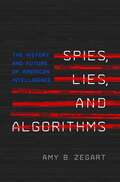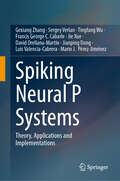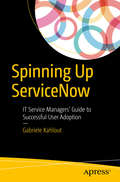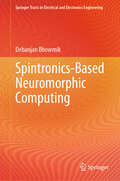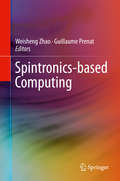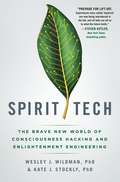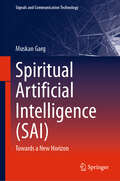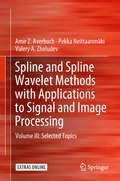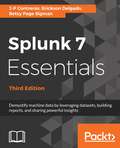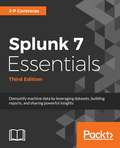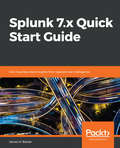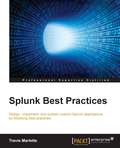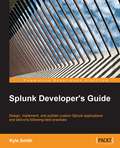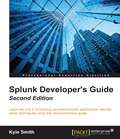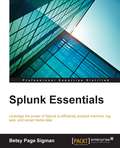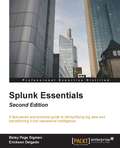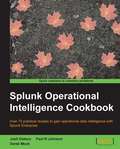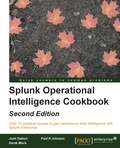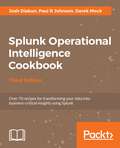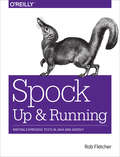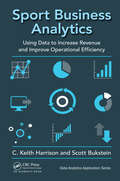- Table View
- List View
Spies, Lies, and Algorithms: The History and Future of American Intelligence
by Amy B. ZegartA riveting account of espionage for the digital age, from one of America’s leading intelligence expertsSpying has never been more ubiquitous—or less understood. The world is drowning in spy movies, TV shows, and novels, but universities offer more courses on rock and roll than on the CIA and there are more congressional experts on powdered milk than espionage. This crisis in intelligence education is distorting public opinion, fueling conspiracy theories, and hurting intelligence policy. In Spies, Lies, and Algorithms, Amy Zegart separates fact from fiction as she offers an engaging and enlightening account of the past, present, and future of American espionage as it faces a revolution driven by digital technology.Drawing on decades of research and hundreds of interviews with intelligence officials, Zegart provides a history of U.S. espionage, from George Washington’s Revolutionary War spies to today’s spy satellites; examines how fictional spies are influencing real officials; gives an overview of intelligence basics and life inside America’s intelligence agencies; explains the deadly cognitive biases that can mislead analysts; and explores the vexed issues of traitors, covert action, and congressional oversight. Most of all, Zegart describes how technology is empowering new enemies and opportunities, and creating powerful new players, such as private citizens who are successfully tracking nuclear threats using little more than Google Earth. And she shows why cyberspace is, in many ways, the ultimate cloak-and-dagger battleground, where nefarious actors employ deception, subterfuge, and advanced technology for theft, espionage, and information warfare.A fascinating and revealing account of espionage for the digital age, Spies, Lies, and Algorithms is essential reading for anyone who wants to understand the reality of spying today.
Spiking Neural P Systems: Theory, Applications and Implementations
by Tingfang Wu Gexiang Zhang Sergey Verlan Mario J. Pérez-Jiménez Jie Xue Francis George Cabarle David Orellana-Martín Jianping Dong Luis Valencia-CabreraSpiking neural P systems represent a significant advancement in the field of membrane computing, drawing inspiration from the communication patterns observed in neurons. Since their inception in 2006, these distributed and parallel neural-like computing models have gained popularity and emerged as important tools within the membrane computing area. As a key branch of the third generation of artificial neural networks, a fascinating research area of artificial intelligence, spiking neural P systems offer a captivating blend of theoretical elegance and practical utility. Their efficiency, Turing completeness, and real-life application characteristics, including interpretability and suitability for large-scale problems, have positioned them at the forefront of contemporary research in membrane computing and artificial intelligence. This state-of-the-art reference work is organized into three parts comprising twelve chapters. It thoroughly investigates the theoretical foundations, real-life applications, and implementations of spiking neural P systems. From fundamental principles to computational power and complexity, the theoretical aspects are explored, laying the groundwork for understanding their practical applications. Real-life applications span a diverse range of domains, including complex optimization, classification, fault diagnosis, medical image processing, information fusion, cryptography, and robot control. Additionally, the book discusses several software and hardware implementations that provide valuable insights into the practical deployment of spiking neural P systems. As the rapid development of spiking neural P systems continues to unfold, there is an increasing demand for a systematic and comprehensive summary of their capabilities and applications. This work serves as an invaluable resource for researchers, scholars, and practitioners interested in the theoretical underpinnings, algorithms, and practical implementation of artificial intelligence and membrane computing.
Spin Dynamics in Two-Dimensional Quantum Materials: A Theoretical Study (Springer Theses)
by Marc Vila TusellThis thesis focuses on the exploration of nontrivial spin dynamics in graphene-based devices and topological materials, using realistic theoretical models and state-of-the-art quantum transport methodologies. The main outcomes of this work are: (i) the analysis of the crossover from diffusive to ballistic spin transport regimes in ultraclean graphene nonlocal devices, and (ii) investigation of spin transport and spin dynamics phenomena (such as the (quantum) spin Hall effect) in novel topological materials, such as monolayer Weyl semimetals WeTe2 and MoTe2. Indeed, the ballistic spin transport results are key for further interpretation of ultraclean spintronic devices, and will enable extracting precise values of spin diffusion lengths in diffusive transport and guide experiments in the (quasi)ballistic regime. Furthermore, the thesis provides an in-depth theoretical interpretation of puzzling huge measured efficiencies of the spin Hall effect in MoTe2, as well as a prediction of a novel canted quantum spin Hall effect in WTe2 with spins pointing in the yz plane.
Spin Out (Lorimer SideStreets)
by Steven SandorBen Cheng used to live the good life—he had wealthy parents, lots of friends, and respect as an online gamer. But when his parents separate, Ben's life changes entirely. He moves to a small apartment with his mom, his dad is out of the picture, and his new schoolmates start teasing him for his family's fall from grace. All Ben has left is his virtual life, where he still reigns supreme as an online racing driver. But when Ben takes his mom's car out for a joyride and gets caught, and uses his mom's credit card without permission, his life starts to spin out. Distributed in the U.S by Lerner Publishing Group
Spinning History: Politics and Propaganda in World War II
by Nathaniel LandeAn “original and insightful” look at World War II through the lens of theater, propaganda, and the most important performances in human history (Richard Cole, PhD). In this fascinating book, more relevant than ever in today’s political climate of “fake news” and “alternative facts,” bestselling author and historian Nathaniel Lande presents WWII as a drama staged and overseen by four contrasting masters: Roosevelt, Churchill, Hitler, and Stalin. Each man had his own script for elaborately produced campaigns of deception, winning hearts and minds on the frontlines and the home front. Each leader used all the tools at his disposal to promote his own narrative of the Second World War. Brilliantly conceived oratory was applied to underscore each vision. Impression management—the art of political spin—was employed to drive the message home. Each side employed uniforms, meticulously staged events, and broadcast their messages via all media available—motion pictures, radio broadcasts, songs, posters, leaflets, and beyond. The result of Lande’s exploration is “an illuminating, readable, and still very relevant account of the ways in which theatrical staging, dramatic storytelling, and message manipulation were key to the efforts of both sides during those turbulent years” (Richard Zoglin, senior editor, Time).
Spinning Up ServiceNow
by Gabriele KahloutLearn how to onboard ServiceNow ITSM tools by evangelizing, educating, and coordinating your organization's service desk, developers, and stakeholders. Drawing on his own story of lessons learned in spinning up the adoption of ServiceNow throughout the Al Jazeera Media Network, application architect Gabriele Kahlout shows IT service managers how to launch automated ServiceNow ticketing tools in seamless integration with their organization's existing email and Active Directory.Spinning Up ServiceNow: IT Service Managers' Guide to Successful User Adoption shows you how to orchestrate your IT service desks and developers to facilitate the adoption and consumption of IT services by all users, supporting their various business needs while optimizing human-computer interaction and minimizing stress and productivity loss arising from poor human-system design.What You'll LearnQuick-start ServiceNow in a matter of days with the minimum configuration required to start processing tickets via emailAvoid the teething problems that can spoil your users’ onboarding experience with ServiceNowAutomate the process of scaling up new teams into ServiceNowShape your users' experiences so that they retain their familiar bearings in email and Active Directory while welcoming the power of ServiceNow enhancementsCreate a strategy to avoid common pitfalls that sabotage ITSM programsWho This Book Is For IT managers charged with implementing ServiceNow ITSM suites in their organizations and business analysts determining the requirements for such implementation. The secondary readership is system administrators and developers involved in ITSM.
Spintronics-Based Neuromorphic Computing (Springer Tracts in Electrical and Electronics Engineering)
by Debanjan BhowmikThe book discusses almost all aspects of spintronics-based neuromorphic computing, starting from a very basic level, and will be of interest to both spintronics and neuromorphic computing communities. The chapters also cover most simulation and experimental studies reported recently by researchers worldwide on this topic. The book includes an introductory chapter on nanomagnetism and spin physics and another on neural network algorithms (covering both the machine-learning and neuroscience aspects of these algorithms). These introductory chapters will help the readers build their background and truly appreciate the recent research results on spintronics-based neuromorphic computing, presented in the later chapters of the book. Various numerical simulation exercises are also provided in the book.
Spintronics-based Computing
by Weisheng Zhao Guillaume PrenatThis book provides a comprehensive introduction to spintronics-based computing for the next generation of ultra-low power/highly reliable logic. It will cover aspects from device to system-level, including magnetic memory cells, device modeling, hybrid circuit structure, design methodology, CAD tools, and technological integration methods. This book is accessible to a variety of readers and little or no background in magnetism and spin electronics are required to understand its content. The multidisciplinary team of expert authors from circuits, devices, computer architecture, CAD and system design reveal to readers the potential of spintronics nanodevices to reduce power consumption, improve reliability and enable new functionality.
Spirit Tech: The Brave New World of Consciousness Hacking and Enlightenment Engineering
by Wesley J. Wildman Kate J. StocklyFeaturing a Foreword by Mikey Siegel, founder of Consciousness Hacking. Technology can now control the spiritual experience. This is a journey through the high-tech aids for psychological growth that are changing our world, while exploring the safety, authenticity and ethics of this new world.We already rely on technology to manage our health, sleep, relationships, and finances, so it’s no surprise that we’re turning to technological aids for the spiritual journey. From apps that help us pray or meditate, to cybernauts seeking the fast track to nirvana through magnetic brain stimulation, we are on the brink of the most transformative revolution in the practice of religion: an era in which we harness the power of “spirit tech” to deepen our experience of the divine.Spirit tech products are rapidly improving in sophistication and power, and ordinary people need a trustworthy guide. Through their own research and insiders’ access to the top innovators and early adopters, Wesley J. Wildman and Kate J. Stockly take you deep inside an evolving world:- Find out how increasingly popular “wearables” work on your brain, promising a shortcut to transformative meditative states.- Meet the inventor of the “God Helmet” who developed a tool to increase psychic skills, and overcome fear, sadness, and anger.- Visit churches that use ayahuasca as their sacrament and explore the booming industry of psychedelic tourism.- Journey to a mansion in the heart of Silicon Valley where a group of scientists and entrepreneurs are working feverishly to bring brain-based spirit tech applications to the masses.- Discover a research team who achieved brain-to-brain communication between individuals thousands of miles apart, harnessing neurofeedback techniques to sync and share emotions among group members.Spirit Tech offers readers a compelling glimpse into the future and is the definitive guide to the fascinating world of new innovations for personal transformation, spiritual growth, and pushing the boundaries of human nature.
Spiritual Artificial Intelligence: Towards a New Horizon (Signals and Communication Technology)
by Muskan GargThis unique book delves into the convergence of artificial intelligence (AI) principles—rooted in scientific knowledge and technological advancements—with the concept of spiritual wellness, exploring their significance in our increasingly automated and digitized world. The author offers a synthesis of two domains often perceived as distinct, appealing to both technologists and spiritual thinkers. Beginning with an exploration of the definitions and scope of "spiritual AI," the book encourages the quantification of spiritual wellness, illustrated through examples from current literature. It sheds light on the evolution of the spiritual quotient, presenting it as an integration of intelligence quotient (IQ) and emotional quotient (EQ), enhanced by dimensions of spirituality. The discussion spans various application domains and delves into the mind's entanglement-like phenomena, raising critical questions: Can a machine truly attain consciousness? How do spiritual wellness and quantum mechanics intertwine? The author invites readers to ask their own questions, contemplate the boundless possibilities of spiritual AI, and challenge existing paradigms.
Spline and Spline Wavelet Methods with Applications to Signal and Image Processing: Volume III: Selected Topics
by Pekka Neittaanmäki Amir Z. Averbuch Valery A. ZheludevThis book provides a practical guide, complete with accompanying Matlab software, to many different types of polynomial and discrete splines and spline-based wavelets, multiwavelets and wavelet frames in signal and image processing applications. In self-contained form, it briefly outlines a broad range of polynomial and discrete splines with equidistant nodes and their signal-processing-relevant properties. In particular, interpolating, smoothing, and shift-orthogonal splines are presented.
Splunk 7 Essentials, Third Edition: Demystify Machine Data By Leveraging Datasets, Building Reports, And Sharing Powerful Insights, 3rd Edition
by J-P ContrerasThis book will uncover the new features in Splunk 7.
Splunk 7 Essentials, Third Edition: Demystify machine data by leveraging datasets, building reports, and sharing powerful insights, 3rd Edition
by Erickson Delgado J-P Contreras Steven Koelpin Elizabeth P SigmanTransform machine data into powerful analytical intelligence using SplunkKey FeaturesAnalyze and visualize machine data to step into the world of Splunk!Leverage the exceptional analysis and visualization capabilities to make informed decisions for your businessThis easy-to-follow, practical book can be used by anyone - even if you have never managed data beforeBook DescriptionSplunk is a search, reporting, and analytics software platform for machine data, which has an ever-growing market adoption rate. More organizations than ever are adopting Splunk to make informed decisions in areas such as IT operations, information security, and the Internet of Things.The first two chapters of the book will get you started with a simple Splunkinstallation and set up of a sample machine data generator, called Eventgen.After this, you will learn to create various reports, dashboards, and alerts. You willalso explore Splunk's Pivot functionality to model data for business users. Youwill then have the opportunity to test-drive Splunk's powerful HTTP Event Collector. After covering the core Splunk functionality, you'll be provided with some real-world best practices for using Splunk, and information on how to build upon what you've learned in this book.Throughout the book, there will be additional comments and best practicerecommendations from a member of the SplunkTrust Community, called"Tips from the Fez". What you will learnInstall and configure Splunk for personal use Store event data in Splunk indexes, classify events into sources, and adddata fields Learn essential Splunk Search Processing Language commandsand best practices Create powerful real-time or user-input dashboards Be proactive by implementing alerts and scheduled reports Tips from the Fez: best practices using Splunk features and add-ons Understand security and deployment considerations for taking Splunk to an organizational levelWho this book is forThis book is for the beginners who want to get well versed in the services offered by Splunk 7. If you want to be a data/business analyst or want to be a system administrator, this book is what you want. No prior knowledge of Splunk is required.
Splunk 7.x Quick Start Guide: Gain business data insights from operational intelligence
by James H. BaxterLearn how to architect, implement, and administer a complex Splunk Enterprise environment and extract valuable insights from business data.Key FeaturesUnderstand the various components of Splunk and how they work together to provide a powerful Big Data analytics solution. Collect and index data from a wide variety of common machine data sourcesDesign searches, reports, and dashboard visualizations to provide business data insightsBook DescriptionSplunk is a leading platform and solution for collecting, searching, and extracting value from ever increasing amounts of big data - and big data is eating the world! This book covers all the crucial Splunk topics and gives you the information and examples to get the immediate job done. You will find enough insights to support further research and use Splunk to suit any business environment or situation.Splunk 7.x Quick Start Guide gives you a thorough understanding of how Splunk works. You will learn about all the critical tasks for architecting, implementing, administering, and utilizing Splunk Enterprise to collect, store, retrieve, format, analyze, and visualize machine data. You will find step-by-step examples based on real-world experience and practical use cases that are applicable to all Splunk environments. There is a careful balance between adequate coverage of all the critical topics with short but relevant deep-dives into the configuration options and steps to carry out the day-to-day tasks that matter.By the end of the book, you will be a confident and proficient Splunk architect and administrator.What you will learnDesign and implement a complex Splunk Enterprise solutionConfigure your Splunk environment to get machine data in and indexedBuild searches to get and format data for analysis and visualizationBuild reports, dashboards, and alerts to deliver critical insightsCreate knowledge objects to enhance the value of your dataInstall Splunk apps to provide focused views into key technologiesMonitor, troubleshoot, and manage your Splunk environmentWho this book is forThis book is intended for experienced IT personnel who are just getting started working with Splunk and want to quickly become proficient with its usage. Data analysts who need to leverage Splunk to extract critical business insights from application logs and other machine data sources will also benefit from this book.
Splunk Best Practices
by Travis MarletteDesign, implement, and publish custom Splunk applications by following best practices About This Book * This is the most up-to-date guide on the market and will help you finish your tasks faster, easier, and more efficiently. * Highly practical guide that addresses common and not-so-common pain points in Splunk. * Want to explore shortcuts to perform tasks more efficiently with Splunk? This is the book for you! Who This Book Is For This book is for administrators, developers, and search ninjas who have been using Splunk for some time. A comprehensive coverage makes this book great for Splunk veterans and newbies alike. What You Will Learn * Use Splunk effectively to gather, analyze, and report on operational data throughout your environment * Expedite your reporting, and be empowered to present data in a meaningful way * Create robust searches, reports, and charts using Splunk * Modularize your programs for better reusability. * Build your own Splunk apps and learn why they are important * Learn how to integrate with enterprise systems * Summarize data for longer term trending, reporting, and analysis In Detail This book will give you an edge over others through insights that will help you in day-to-day instances. When you're working with data from various sources in Splunk and performing analysis on this data, it can be a bit tricky. With this book, you will learn the best practices of working with Splunk. You'll learn about tools and techniques that will ease your life with Splunk, and will ultimately save you time. In some cases, it will adjust your thinking of what Splunk is, and what it can and cannot do. To start with, you'll get to know the best practices to get data into Splunk, analyze data, and package apps for distribution. Next, you'll discover the best practices in logging, operations, knowledge management, searching, and reporting. To finish off, we will teach you how to troubleshoot Splunk searches, as well as deployment, testing, and development with Splunk. Style and approach If you're stuck or want to find a better way to work with Splunk environment, this book will come handy. This easy-to-follow, insightful book contains step-by-step instructions and examples and scenarios that you will connect to.
Splunk Certified Study Guide: Prepare for the User, Power User, and Enterprise Admin Certifications
by Deep MehtaMake your Splunk certification easier with this exam study guide that covers the User, Power User, and Enterprise Admin certifications. This book is divided into three parts. The first part focuses on the Splunk User and Power User certifications starting with how to install Splunk, Splunk Processing Language (SPL), field extraction, field aliases and macros, and Splunk tags. You will be able to make your own data model and prepare an advanced dashboard in Splunk.In the second part, you will explore the Splunk Admin certification. There will be in-depth coverage of Splunk licenses and user role management, and how to configure Splunk forwarders, indexer clustering, and the security policy of Splunk. You’ll also explore advanced data input options in Splunk as well as .conf file merging logic, btool, various attributes, stanza types, editing advanced data inputs through the .conf file, and various other types of .conf file in Splunk.The concluding part covers the advanced topics of the Splunk Admin certification. You will also learn to troubleshoot Splunk and to manage existing Splunk infrastructure. You will understand how to configure search head, multi-site indexer clustering, and search peers besides exploring how to troubleshoot Splunk Enterprise using the monitoring console and matrix.log. This part will also include search issues and configuration issues. You will learn to deploy an app through a deployment server on your client’s instance, create a server class, and carry out load balancing, socks proxy, and indexer discovery.By the end of the Splunk Certified Study Guide, you will have learned how to manage resources in Splunk and how to use REST API services for Splunk. This section also explains how to set up Splunk Enterprise on the AWS platform and some of the best practices to make them work efficiently together.The book offers multiple choice question tests for each part that will help you better prepare for the exam.What You Will LearnStudy to pass the Splunk User, Power User, and Admin certificate examsImplement and manage Splunk multi-site clusteringDesign, implement, and manage a complex Splunk Enterprise solutionMaster the roles of Splunk Admin and troubleshootingConfigure Splunk using AWSWho This Book Is For People looking to pass the User, Power User, and Enterprise Admin exams. It is also useful for Splunk administrators and support engineers for managing an existing deployment.
Splunk Developer's Guide
by Kyle SmithIf you are a Splunk user and want to enter the wonderful world of Splunk application development, then this book is for you. Some experience with Splunk, writing searches, and designing basic dashboards is expected.
Splunk Developer's Guide - Second Edition
by Kyle SmithLearn the A to Z of building excellent Splunk applications with the latest techniques using this comprehensive guide About This Book * This is the most up-to-date book on Splunk 6.3 for developers * Get ahead of being just a Splunk user and start creating custom Splunk applications as per your needs * Your one-stop-solution to Splunk application development Who This Book Is For This book is for those who have some familiarity with Splunk and now want to learn how to develop an efficient Splunk application. Previous experience with Splunk, writing searches, and designing basic dashboards is expected. What You Will Learn * Implement a Modular Input and a custom D3 data visualization * Create a directory structure and set view permissions * Create a search view and a dashboard view using advanced XML modules * Enhance your application using eventtypes, tags, and macros * Package a Splunk application using best practices * Publish a Splunk application to the Splunk community In Detail Splunk provides a platform that allows you to search data stored on a machine, analyze it, and visualize the analyzed data to make informed decisions. The adoption of Splunk in enterprises is huge, and it has a wide range of customers right from Adobe to Dominos. Using the Splunk platform as a user is one thing, but customizing this platform and creating applications specific to your needs takes more than basic knowledge of the platform. This book will dive into developing Splunk applications that cater to your needs of making sense of data and will let you visualize this data with the help of stunning dashboards. This book includes everything on developing a full-fledged Splunk application right from designing to implementing to publishing. We will design the fundamentals to build a Splunk application and then move on to creating one. During the course of the book, we will cover application data, objects, permissions, and more. After this, we will show you how to enhance the application, including branding, workflows, and enriched data. Views, dashboards, and web frameworks are also covered. This book will showcase everything new in the latest version of Splunk including the latest data models, alert actions, XML forms, various dashboard enhancements, and visualization options (with D3). Finally, we take a look at the latest Splunk cloud applications, advanced integrations, and development as per the latest release. Style and approach This book is an easy-to-follow guide with lots of tips and tricks to help you master all the concepts necessary to develop and deploy your Splunk applications.
Splunk Essentials
by Betsy Page SigmanThis book is intended for a business person, analyst, or student who wants to quickly learn how to use Splunk to manage data. It would be helpful to have a bit of familiarity with basic computer concepts, but no prior experience of Splunk is required.
Splunk Essentials - Second Edition
by Betsy Page Sigman Erickson DelgadoA fast-paced and practical guide to demystifying big data and transforming it into operational intelligence About This Book * Want to get started with Splunk to analyze and visualize machine data? Open this book and step into the world of Splunk. * Leverage the exceptional analysis and visualization capabilities to make informed decisions for your business * This easy-to-follow, practical book can be used by anyone, even if you have never managed any data before Who This Book Is For This book will be perfect for you if you are a Software engineer or developer or System administrators or Business analyst who seek to correlate machine data with business metrics and provide intuitive real-time and statistical visualizations. Some knowledge or experience of previous versions of Splunk will be helpful but not essential. What You Will Learn * Install and configure Splunk * Gather data from different sources, isolate them by indexes, classify them into source types, and tag them with the essential fields * Be comfortable with the Search Processing Language and get to know the best practices in writing search queries * Create stunning and powerful dashboards * Be proactive by implementing alerts and scheduled reports * Use the Splunk SDK and integrate Splunk data into other applications * Implement the best practices in using Splunk. In Detail Splunk is a search, analysis, and reporting platform for machine data, which has a high adoption on the market. More and more organizations want to adopt Splunk to use their data to make informed decisions. This book is for anyone who wants to manage data with Splunk. You'll start with very basics of Splunk-- installing Splunk--and then move on to searching machine data with Splunk. You will gather data from different sources, isolate them by indexes, classify them into source types, and tag them with the essential fields. After this, you will learn to create various reports, XML forms, and alerts. You will then continue using the Pivot Model to transform the data models into visualization. You will also explore visualization with D3 in Splunk. Finally you'll be provided with some real-world best practices in using Splunk. Style and approach This fast-paced, example-rich guide will help you analyze and visualize machine data with Splunk through simple, practical instructions.
Splunk Operational Intelligence Cookbook
by Paul R Johnson Josh DiakunThis book is intended for users of all levels who are looking to leverage the Splunk Enterprise platform as a valuable operational intelligence tool. The recipes provided in this book will appeal to individuals from all facets of a business - IT, Security, Product, Marketing, and many more!
Splunk Operational Intelligence Cookbook - Second Edition
by Paul R Johnson Josh Diakun Derek MockOver 70 practical recipes to gain operational data intelligence with Splunk Enterprise About This Book * This is the most up-to-date book on Splunk 6.3 and teaches you how to tackle real-world operational intelligence scenarios efficiently * Get business insights using machine data using this easy-to-follow guide * Search, monitor, and analyze your operational data skillfully using this recipe-based, practical guide Who This Book Is For This book is intended for users of all levels who are looking to leverage the Splunk Enterprise platform as a valuable operational intelligence tool. The recipes provided in this book will appeal to individuals from all facets of business, IT, security, product, marketing, and many more! Also, existing users of Splunk who want to upgrade and get up and running with Splunk 6.3 will find this book invaluable. What You Will Learn * Use Splunk to gather, analyze, and report on data * Create dashboards and visualizations that make data meaningful * Build an operational intelligence application with extensive features and functionality * Enrich operational data with lookups and workflows * Model and accelerate data and perform pivot-based reporting * Build real-time, scripted, and other intelligence-driven alerts * Summarize data for longer term trending, reporting, and analysis * Integrate advanced JavaScript charts and leverage Splunk's API In Detail Splunk makes it easy for you to take control of your data, and with Splunk Operational Cookbook, you can be confident that you are taking advantage of the Big Data revolution and driving your business with the cutting edge of operational intelligence and business analytics. With more than 70 recipes that demonstrate all of Splunk's features, not only will you find quick solutions to common problems, but you'll also learn a wide range of strategies and uncover new ideas that will make you rethink what operational intelligence means to you and your organization. You'll discover recipes on data processing, searching and reporting, dashboards, and visualizations to make data shareable, communicable, and most importantly meaningful. You'll also find step-by-step demonstrations that walk you through building an operational intelligence application containing vital features essential to understanding data and to help you successfully integrate a data-driven way of thinking in your organization. Throughout the book, you'll dive deeper into Splunk, explore data models and pivots to extend your intelligence capabilities, and perform advanced searching to explore your data in even more sophisticated ways. Splunk is changing the business landscape, so make sure you're taking advantage of it. Style and approach Splunk is an excellent platform that allows you to make sense of machine data with ease. The adoption of Splunk has been huge and everyone who has gone beyond installing Splunk wants to know how to make most of it. This book will not only teach you how to use Splunk in real-world scenarios to get business insights, but will also get existing Splunk users up to date with the latest Splunk 6.3 release.
Splunk Operational Intelligence Cookbook: Over 80 recipes for transforming your data into business-critical insights using Splunk, 3rd Edition
by Paul R Johnson Josh Diakun Derek MockLeverage Splunk's operational intelligence capabilities to unlock new hidden business insights and drive successKey FeaturesTackle any problems related to searching and analyzing your data with Splunk Get the latest information and business insights on Splunk 7.x Explore the all new machine learning toolkit in Splunk 7.xBook DescriptionSplunk makes it easy for you to take control of your data, and with Splunk Operational Cookbook, you can be confident that you are taking advantage of the Big Data revolution and driving your business with the cutting edge of operational intelligence and business analytics.With more than 80 recipes that demonstrate all of Splunk’s features, not only will you find quick solutions to common problems, but you’ll also learn a wide range of strategies and uncover new ideas that will make you rethink what operational intelligence means to you and your organization.You’ll discover recipes on data processing, searching and reporting, dashboards, and visualizations to make data shareable, communicable, and most importantly meaningful. You’ll also find step-by-step demonstrations that walk you through building an operational intelligence application containing vital features essential to understanding data and to help you successfully integrate a data-driven way of thinking in your organization.Throughout the book, you’ll dive deeper into Splunk, explore data models and pivots to extend your intelligence capabilities, and perform advanced searching with machine learning to explore your data in even more sophisticated ways. Splunk is changing the business landscape, so make sure you’re taking advantage of it.What you will learnLearn how to use Splunk to gather, analyze, and report on dataCreate dashboards and visualizations that make data meaningfulBuild an intelligent application with extensive functionalitiesEnrich operational data with lookups and workflowsModel and accelerate data and perform pivot-based reportingApply ML algorithms for forecasting and anomaly detectionSummarize data for long term trending, reporting, and analysisIntegrate advanced JavaScript charts and leverage Splunk's APIWho this book is forThis book is intended for data professionals who are looking to leverage the Splunk Enterprise platform as a valuable operational intelligence tool. The recipes provided in this book will appeal to individuals from all facets of business, IT, security, product, marketing, and many more! Even the existing users of Splunk who want to upgrade and get up and running with Splunk 7.x will find this book to be of great value.
Spock: Writing Expressive Tests in Java and Groovy
by Rob FletcherMost developers would agree that writing automated tests is a good idea, but writing good, well-structured tests is still an elusive skill for many. For Java and Groovy developers, however, there’s good news. This practical guide shows you how to write concise and highly readable tests with Spock, the most innovative testing and specification framework for the JVM since JUnit.Author Rob Fletcher takes you from Spock basics to advanced topics, using fully worked integration examples. Through the course of this book, you’ll build a simple web application—Squawker—that allows users to post short messages. You’ll discover how much easier it is to write automated tests with Spock’s straightforward and expressive language.Start by learning how to write simple unit testsUnderstand the lifecycle of Spock specifications and feature methodsDive into interaction testing, using Spock’s intuitive syntax for dealing with mocks and stubsLearn about parameterized tests—writing feature methods that run for multiple sets of dataMove into advanced topics, such as writing idiomatic Spock code and driving parameterized tests with file or database inputLearn how everything works together in a standalone, fully-worked, test-driven development example
Sport Business Analytics: Using Data to Increase Revenue and Improve Operational Efficiency (Data Analytics Applications)
by Scott Bukstein C. HarrisonDeveloping and implementing a systematic analytics strategy can result in a sustainable competitive advantage within the sport business industry. This timely and relevant book provides practical strategies to collect data and then convert that data into meaningful, value-added information and actionable insights. Its primary objective is to help sport business organizations utilize data-driven decision-making to generate optimal revenue from such areas as ticket sales and corporate partnerships. To that end, the book includes in-depth case studies from such leading sports organizations as the Orlando Magic, Tampa Bay Buccaneers, Duke University, and the Aspire Group. The core purpose of sport business analytics is to convert raw data into information that enables sport business professionals to make strategic business decisions that result in improved company financial performance and a measurable and sustainable competitive advantage. Readers will learn about the role of big data and analytics in: Ticket pricing Season ticket member retention Fan engagement Sponsorship valuation Customer relationship management Digital marketing Market research Data visualization. This book examines changes in the ticketing marketplace and spotlights innovative ticketing strategies used in various sport organizations. It shows how to engage fans with social media and digital analytics, presents techniques to analyze engagement and marketing strategies, and explains how to utilize analytics to leverage fan engagement to enhance revenue for sport organizations. Filled with insightful case studies, this book benefits both sports business professionals and students. The concluding chapter on teaching sport analytics further enhances its value to academics.
